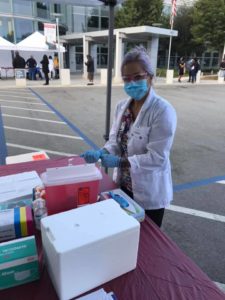The virus was projected by public health officials to be the third leading cause of death, following heart disease and cancer
Editorial is the opinion of Morgan Hill Life
When it comes to the COVID-19 crisis in 2021, Americans have good news and bad news.
The good news is that pharmaceutical companies are starting to ramp up the distribution and public inoculation of vaccines to combat the spread of this dangerous disease — and eventually achieve herd immunity. The bad news is that the rollout of these drugs is much slower than first planned. The required number of Americans — about 70 percent of the population, according to Dr. Anthony Fauci — will not likely receive their two shots until autumn or even next winter. Our lives will not get back to pre-pandemic conditions this year.
 Let’s face the painful reality of this health crisis. Despite the vaccines, we are not anywhere close to finishing the fight, especially now as we are starting to see in January and February the toll rise in confirmed cases and deaths following the month-long period of the holiday season. Adding to the danger is a new strain of the disease that evolved in the United Kingdom and is much more contagious than the virus we first encountered. It is now confirmed to be in California, including possibly the Bay Area.
Let’s face the painful reality of this health crisis. Despite the vaccines, we are not anywhere close to finishing the fight, especially now as we are starting to see in January and February the toll rise in confirmed cases and deaths following the month-long period of the holiday season. Adding to the danger is a new strain of the disease that evolved in the United Kingdom and is much more contagious than the virus we first encountered. It is now confirmed to be in California, including possibly the Bay Area.
As the year 2020 ended with 673 fatalities from COVID-19 and 67,581 confirmed cases in Santa Clara County, the virus was projected by county public health officials to be the third leading cause of death, following heart disease and cancer. It could have been on the top of the list. This tragic cost in human lives could have been three or even four times as devastating if the public had failed to take actions to prevent its spreading widely such as wearing masks, social distancing, avoiding large gatherings such as concerts and festivals, and sheltering in place.
 Despite the data, there is a small but vocal group of skeptics throughout the county who still question the validity of the danger to public health. Some people even believe the coronavirus is a “hoax” perpetrated in some diabolical political conspiracy. For many people, seeing is believing. The fact that these deaths and severe illnesses usually take place in private and isolation in the ICU wards makes it hard for some people to accept the reality of the risk. There are even reports of Americans who have contracted the disease denying until their dying breath that the threat is real.
Despite the data, there is a small but vocal group of skeptics throughout the county who still question the validity of the danger to public health. Some people even believe the coronavirus is a “hoax” perpetrated in some diabolical political conspiracy. For many people, seeing is believing. The fact that these deaths and severe illnesses usually take place in private and isolation in the ICU wards makes it hard for some people to accept the reality of the risk. There are even reports of Americans who have contracted the disease denying until their dying breath that the threat is real.
We’re now just starting to witness the painful impact of last month’s holiday gatherings. In mid-November, a week before Thanksgiving, an average of three people in Santa Clara County died per day from the disease. A month later, that average increased to nearly six people per day. The county’s seven-day average positivity rate as of Dec. 13 was 7.7 percent, the highest since the pandemic began in March. That’s compared to 3.4 percent on Nov. 19, one week before Thanksgiving Day, and 1.3 percent on May 27. Those numbers will grow as families and friends resisted the plea by county leaders to avoid gathering to celebrate Christmas and New Year’s Eve.
These gatherings fueled the spread of the virus to a point in mid-January where the growing number of cases has completely overwhelmed our county’s health systems, bringing them to the breaking point. Health professionals including nurses and doctors are fatigued. St. Louise Regional Hospital in Gilroy has no ICU beds available. Patients are now filling surge beds. If nurses and doctors are forced to go beyond the surge capacity in treating coronavirus, the quality of our public health will decline to dangerous levels.
 In the county, the Latino community is by far the demographic group most affected. Data shows 52 percent of all COVID-19 cases are made up of people in this group that represents about a quarter of the county’s population. One of the reasons why is that many individuals in this demographic group work in jobs that force them to face a greater risk of exposure to the virus. They also live in households where others make their livelihoods where they are more susceptible to catching the coronavirus. Gilroy has a population made up of about 55 percent Latino, the highest in the county. The city has had about 10 percent of its residents listed on the toll of COVID-19 confirmed cases, with as many as 25 people dead from the disease according to the county. Compare that to Morgan Hill with 5 percent of its population as confirmed cases and zero coronavirus deaths, according to the county.
In the county, the Latino community is by far the demographic group most affected. Data shows 52 percent of all COVID-19 cases are made up of people in this group that represents about a quarter of the county’s population. One of the reasons why is that many individuals in this demographic group work in jobs that force them to face a greater risk of exposure to the virus. They also live in households where others make their livelihoods where they are more susceptible to catching the coronavirus. Gilroy has a population made up of about 55 percent Latino, the highest in the county. The city has had about 10 percent of its residents listed on the toll of COVID-19 confirmed cases, with as many as 25 people dead from the disease according to the county. Compare that to Morgan Hill with 5 percent of its population as confirmed cases and zero coronavirus deaths, according to the county.
 County health officials anticipate the number of new cases of coronavirus and hospitalizations to save lives will continue to rise in the coming weeks. We’re facing a grim January and February in rising death tolls and confirmed cases. Vaccines are still months away from reaching most of the general public. Let’s all be smart in 2021 and take simple but effective actions to protect not just ourselves but our loved ones and everyone else in our community.
County health officials anticipate the number of new cases of coronavirus and hospitalizations to save lives will continue to rise in the coming weeks. We’re facing a grim January and February in rising death tolls and confirmed cases. Vaccines are still months away from reaching most of the general public. Let’s all be smart in 2021 and take simple but effective actions to protect not just ourselves but our loved ones and everyone else in our community.







